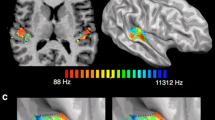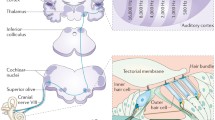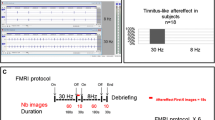Abstract
Introduction
Tinnitus is hypothesized to be an auditory phantom phenomenon resulting from spontaneous neuronal activity somewhere along the auditory pathway. We performed fMRI of the entire auditory pathway, including the inferior colliculus (IC), the medial geniculate body (MGB) and the auditory cortex (AC), in 42 patients with tinnitus and 10 healthy volunteers to assess lateralization of fMRI activation.
Methods
Subjects were scanned on a 3T MRI scanner. A T2*-weighted EPI silent gap sequence was used during the stimulation paradigm, which consisted of a blocked design of 12 epochs in which music presented binaurally through headphones, which was switched on and off for periods of 50 s. Using SPM2 software, single subject and group statistical parametric maps were calculated. Lateralization of activation was assessed qualitatively and quantitatively.
Results
Tinnitus was lateralized in 35 patients (83%, 13 right-sided and 22 left-sided). Significant signal change (P corrected < 0.05) was found bilaterally in the primary and secondary AC, the IC and the MGB. Signal change was symmetrical in patients with bilateral tinnitus. In patients with lateralized tinnitus, fMRI activation was lateralized towards the side of perceived tinnitus in the primary AC and IC in patients with right-sided tinnitus, and in the MGB in patients with left-sided tinnitus. In healthy volunteers, activation in the primary AC was left-lateralized.
Conclusion
Our paradigm adequately visualized the auditory pathways in tinnitus patients. In lateralized tinnitus fMRI activation was also lateralized, supporting the hypothesis that tinnitus is an auditory phantom phenomenon.





Similar content being viewed by others
References
Axelsson A, Ringdahl A (1989) Tinnitus – a study of its prevalence and characteristics. Br J Audiol 23:53–62
Heller AJ (2003) Classification and epidemiology of tinnitus. Otolaryngol Clin North Am 36:239–248
Weissman JL, Hirsch BE (2000) Imaging of tinnitus: a review. Radiology 2:342–349
De Ridder D, De Mulder G, Walsh V, Muggleton N, Sunaert S, Moller A (2004) Magnetic and electrical stimulation of the auditory cortex for intractable tinnitus. Case report. J Neurosurg 100:560–564
Muhlnickel W, Lutzenberger W, Flor H (1999) Localization of somatosensory evoked potentials in primary somatosensory cortex: a comparison between PCA and MUSIC. Brain Topogr 11:185–191
Meyershoff W (1992) Tinnitus. In: Meyershoff W, Ria D (eds) Otolaryngology head and neck surgery. WB Saunders, Philadelphia, pp 435–446
Eggermont JJ (2003) Central tinnitus. Auris Nasus Larynx 30 [Suppl]:S7–S12
Jastreboff PJ (1990) Phantom auditory perception (tinnitus): mechanisms of generation and perception. Neurosci Res 8:221–254
Giraud AL, Chery-Croze S, Fischer G, Fischer C, Vighetto A, Gregoire MC, Lavenne F, Collet L (1999) A selective imaging of tinnitus. Neuroreport 10:1–5
Muhlnickel W, Elbert T, Taub E, Flor H (1998) Reorganization of auditory cortex in tinnitus. Proc Natl Acad Sci USA 95:10340–10343
Kaltenbach JA (2000) Neurophysiologic mechanisms of tinnitus. J Am Acad Audiol 11:125–137
De Ridder D, Ryu H, Moller AR, Nowe V, Van de Heyning P, Verlooy J (2004) Functional anatomy of the human cochlear nerve and its role in microvascular decompressions for tinnitus. Neurosurgery 54:381–388; discussion 388–390
Chowdhury SA, Suga N (2000) Reorganization of the frequency map of the auditory cortex evoked by cortical electrical stimulation in the big brown bat. J Neurophysiol 83:1856–1863
Robertson D, Irvine DR (1989) Plasticity of frequency organization in auditory cortex of guinea pigs with partial unilateral deafness. J Comp Neurol 282:456–471
Mirz F, Pedersen B, Ishizu K, Johannsen P, Ovesen T, Stodkilde-Jorgensen H, Gjedde A (1999) Positron emission tomography of cortical centers of tinnitus. Hear Res 134:133–144
Mirz F, Gjedde A, Ishizu K, Pedersen CB (2000) Cortical networks subserving the perception of tinnitus – a PET study. Acta Otolaryngol Suppl 543:241–243
Lockwood AH, Salvi RJ, Coad ML, Towsley ML, Wack DS, Murphy BW (1998) The functional neuroanatomy of tinnitus: evidence for limbic system links and neural plasticity. Neurology 50:114–120
Arnold W, Bartenstein P, Oestreicher E, Romer W, Schwaiger M (1996) Focal metabolic activation in the predominant left auditory cortex in patients suffering from tinnitus: a PET study with [18F]deoxyglucose. ORL J Otorhinolaryngol Relat Spec 58:195–199
Gardner A, Pagani M, Jacobsson H, Lindberg G, Larsson SA, Wagner A, Hallstrom T (2002) Differences in resting state regional cerebral blood flow assessed with 99mTc-HMPAO SPECT and brain atlas matching between depressed patients with and without tinnitus. Nucl Med Commun 23:429–439
Cacace AT (2003) Expanding the biological basis of tinnitus: crossmodal origins and the role of neuroplasticity. Hear Res 175:112–132
Cacace AT, Cousins JP, Parnes SM, Semenoff D, Holmes T, McFarland DJ, Davenport C, Stegbauer K, Lovely TJ (1999) Cutaneous-evoked tinnitus. I. Phenomenology, pschychophysics and functional imaging. Audiol Neurootol 4:247–257
Ballester M, Lovblad KO, Nirkko AC, Vibert D, Romanet P, Schroth G, Hausler R (2001) Functional MRI of tinnitus – preliminary results using echo-planar imaging (abstract). Neuroimage 13:379
Melcher JR, Sigalovsky IS, Guinan JJ, Levine RA (2000) Lateralized tinnitus studied with functional magnetic resonance imaging: abnormal inferior colliculus activation. J Neurophysiol 83:1058–1072
Friston KJ, Williams S, Howard R, Frackowiak RS, Turner R (1996) Movement-related effects in fMRI time-series. Magn Reson Med 35:346–355
Friston KJ, Josephs O, Zarahn E, Holmes AP, Rouquette S, Poline J (2000) To smooth or not to smooth? Bias and efficiency in fMRI time-series analysis. Neuroimage 12:196–208
Worsley KJ, Friston KJ (1995) Analysis of fMRI time-series revisited – again. Neuroimage 2:173–181
Friston KJ, Holmes AP, Price CJ, Buchel C, Worsley KJ (1999) Multisubject fMRI studies and conjunction analyses. Neuroimage 10:385–396
Brett M, Anton J-L, Valabregue R, Poline J-B (2002) Region of interest analysis using an SPM toolbox (abstract). Proceedings of the 8th International Conference on Functional Mapping of the Human Brain, vol 16. 2–6 June, Sendai, Japan, p 497
Duncan J, Seitz RJ, Kolodny J, Bor D, Herzog H, Ahmed A, Newell FN, Emslie H (2000) A neural basis for general intelligence. Science 289:457–460
Calder AJ, Lawrence AD, Young AW (2001) Neuropsychology of fear and loathing. Nat Rev Neurosci 2:352–363
Cacace AT, Tasciyan T, Cousins JP (2000) Principles of functional magnetic resonance imaging: application to auditory neuroscience. J Am Acad Audiol 11:239–272
Bernal B, Altman NR (2001) Auditory functional MR imaging. AJR Am J Roentgenol 176:1009–1015
Johnsrude IS, Giraud AL, Frackowiak RS (2002) Functional imaging of the auditory system: the use of positron emission tomography. Audiol Neurootol 7:251–276
Cho ZH, Chung SC, Lim DW, Wong EK (1998) Effects of the acoustic noise of the gradient systems on fMRI: a study on auditory, motor, and visual cortices. Magn Reson Med 39:331–335
Elliott MR, Bowtell RW, Morris PG (1999) The effect of scanner sound in visual, motor, and auditory functional MRI. Magn Reson Med 41:1230–1235
Lovblad KO, Thomas R, Jakob PM, Scammell T, Bassetti C, Griswold M, Ives J, Matheson J, Edelman RR, Warach S (1999) Silent functional magnetic resonance imaging demonstrates focal activation in rapid eye movement sleep. Neurology 53:2193–2195
Amaro E Jr, Williams SC, Shergill SS, Fu CH, MacSweeney M, Picchioni MM, Brammer MJ, McGuire PK (2002) Acoustic noise and functional magnetic resonance imaging: current strategies and future prospects. J Magn Reson Imaging 16:497–510
Hall DA, Haggard MP, Akeroyd MA, Palmer AR, Summerfield AQ, Elliott MR, Gurney EM, Bowtell RW (1999) “Sparse” temporal sampling in auditory fMRI. Hum Brain Mapp 7:213–223
Edmister WB, Talavage TM, Ledden PJ, Weisskoff RM (1999) Improved auditory cortex imaging using clustered volume acquisitions. Hum Brain Mapp 7:89–97
Yetkin FZ, Roland PS, Purdy PD, Christensen WF (2003) Evaluation of auditory cortex activation by using silent fMRI. Am J Otolaryngol 24:281–289
Kovacs S, Peeters R, Smits M, De Ridder D, Van Hecke P, Sunaert S (2006) Activation of cortical and subcortical auditory structures at 3 T by means of a functional magnetic resonance imaging paradigm suitable for clinical use. Invest Radiol 41:87–96
Yoo SS, O’Leary HM, Dickey CC, Wei XC, Guttmann CR, Park HW, Panych LP (2005) Functional asymmetry in human primary auditory cortex: identified from longitudinal fMRI study. Neurosci Lett 383:1–6
Devlin JT, Raley J, Tunbridge E, Lanary K, Floyer-Lea A, Narain C, Cohen I, Behrens T, Jezzard P, Matthews PM, Moore DR (2003) Functional asymmetry for auditory processing in human primary auditory cortex. J Neurosci 23:11516–11522
Lurito JT, Dzemidzic M (2001) Determination of cerebral hemisphere language dominance with functional magnetic resonance imaging. Neuroimaging Clin N Am 11:355–363, x
Gainotti G (1972) Emotional behavior and hemispheric side of the lesion. Cortex 8:41–55
Hallberg LR, Erlandsson SI (1993) Tinnitus characteristics in tinnitus complainers and noncomplainers. Br J Audiol 27:19–27
Mirz F, Gjedde A, Sodkilde-Jrgensen H, Pedersen CB (2000) Functional brain imaging of tinnitus-like perception induced by aversive auditory stimuli. Neuroreport 11:633–637
Cacace AT, Cousins JP, Parnes SM, McFarland DJ, Semenoff D, Holmes T, Davenport C, Stegbauer K, Lovely TJ (1999) Cutaneous-evoked tinnitus. II. Review of neuroanatomical, physiological and functional imaging studies. Audiol Neurootol 4:258–268
Acknowledgements
This study was made possible with funding from a European Union Marie-Curie Fellowship and from “Fonds voor Wetenschappelijk Onderzoek (FWO)-Flanders Wetenschappelijke Onderzoeksgemeenschap (WOG) on Advanced Nuclear Magnetic Resonance (NMR)”. The authors wish to thank Mr. P. Hamaekers, Senior Research Nurse, for technical support.
Conflict of interest statement
We declare that we have no conflict of interest.
The principal author (M.S.) received funding through a European Marie-Curie Fellowship and from FWO-Flanders WOG on Advanced NMR. The authors’ work was independent of the funding organizations. The funding organizations had no involvement in the study design, data collection and analysis, writing the report, or the decision to submit the paper for publication.
Author information
Authors and Affiliations
Corresponding author
Rights and permissions
About this article
Cite this article
Smits, M., Kovacs, S., de Ridder, D. et al. Lateralization of functional magnetic resonance imaging (fMRI) activation in the auditory pathway of patients with lateralized tinnitus. Neuroradiology 49, 669–679 (2007). https://doi.org/10.1007/s00234-007-0231-3
Received:
Accepted:
Published:
Issue Date:
DOI: https://doi.org/10.1007/s00234-007-0231-3




